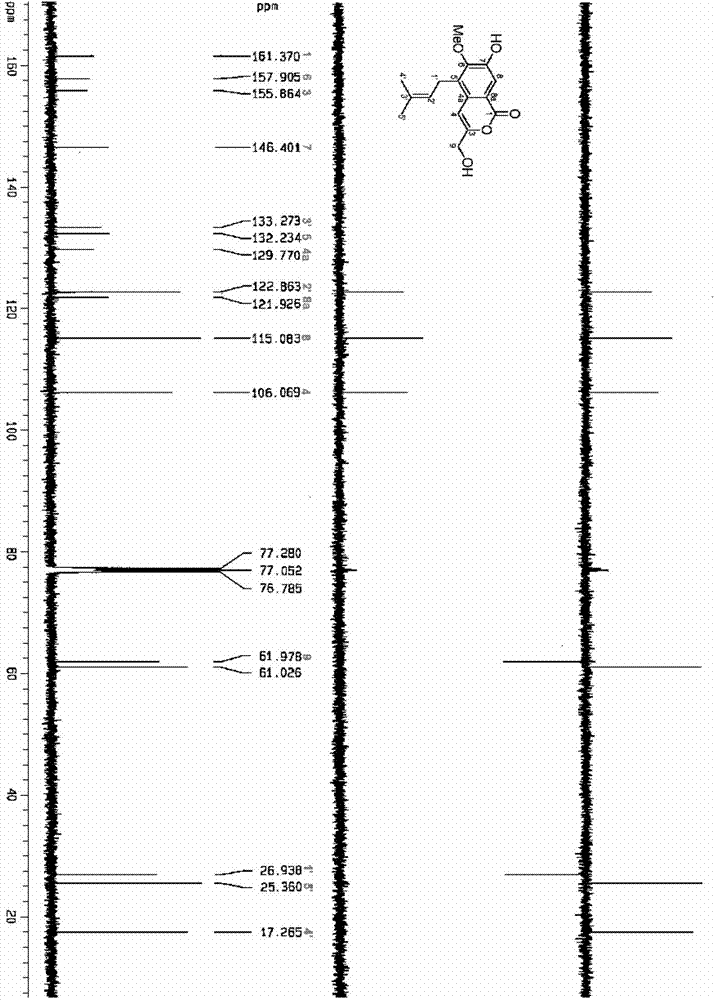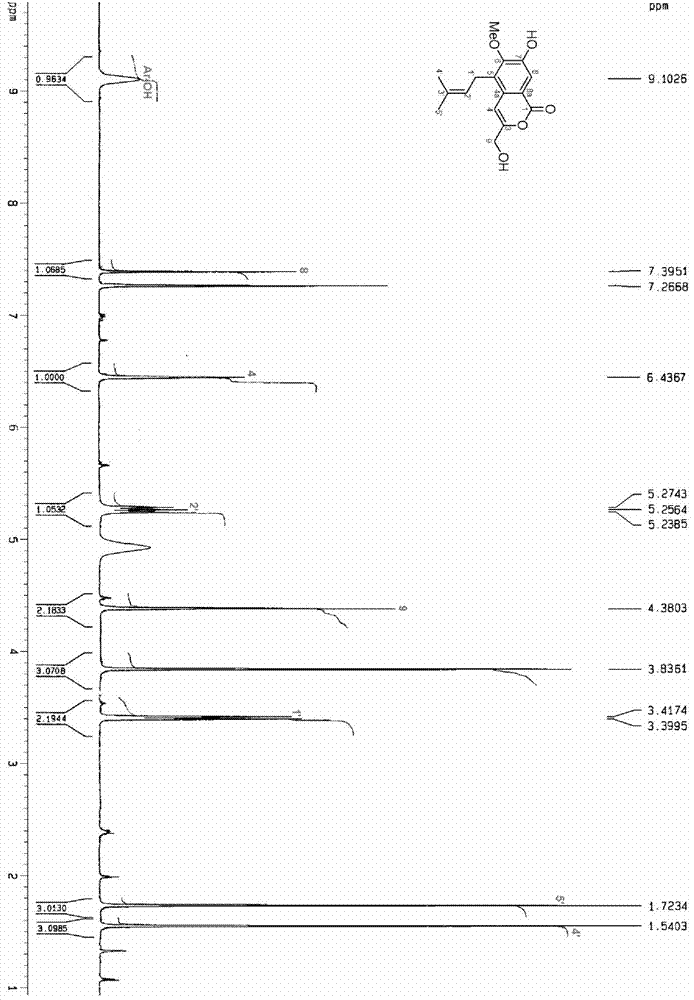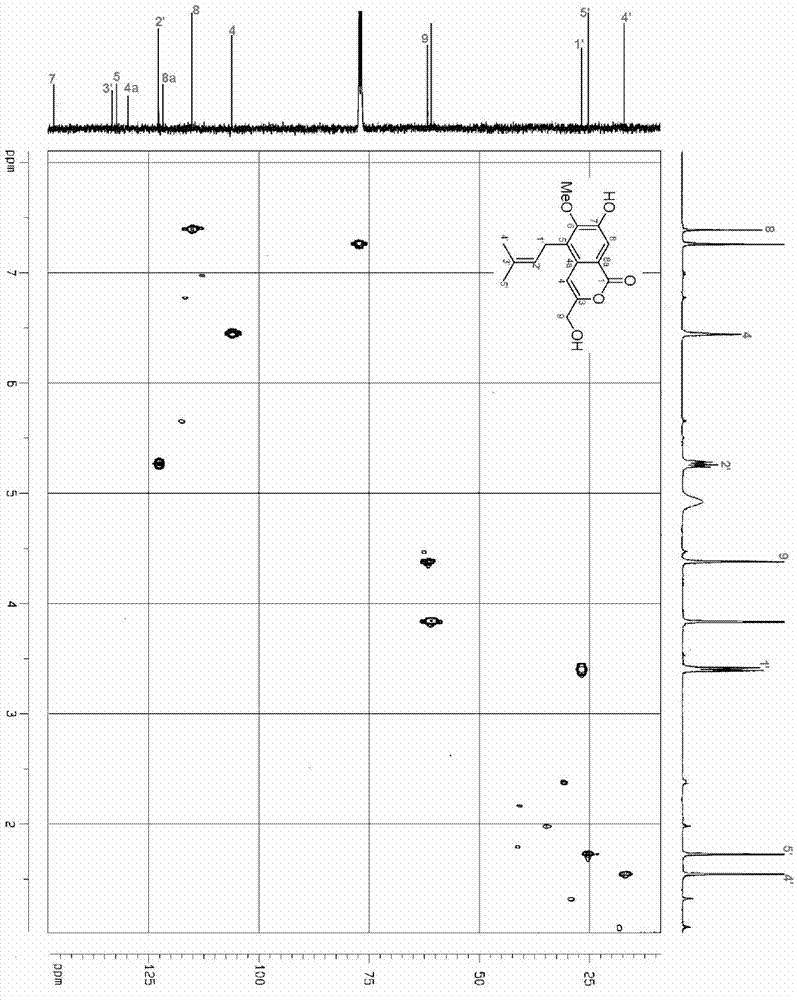Isocoumarin compound and preparation method and application thereof
A technology of isocoumarin and compounds, applied in the field of extraction and separation of plant effective components
- Summary
- Abstract
- Description
- Claims
- Application Information
AI Technical Summary
Problems solved by technology
Method used
Image
Examples
preparation example Construction
[0027] The preparation method of the isocoumarin compound of the present invention is to use the three tendons of dry Lauraceae plant hairy leaves ( Lindera caudata ) as a raw material obtained through extract extraction, organic solvent extraction, MCI decolorization, silica gel column chromatography, and high-pressure liquid chromatography separation steps, specifically:
[0028] A, extraction of extract: the three tendons of Lauraceae plant hairy leaves ( Lindera caudata ) was crushed to 20-40 mesh, ultrasonically extracted 2-5 times with an organic solvent, 30-60 minutes each time, the extracts were combined, filtered, concentrated extracts under reduced pressure, left to stand, filtered to remove sediment, concentrated into extract a;
[0029] B. Organic solvent extraction: Add 1 to 2 times the amount of water by weight to the extract a, extract 3 to 5 times with an organic solvent equal to the volume of water, combine the organic solvent extraction phase, and concentrat...
Embodiment 1
[0044] Take 1.5 kg of dry three-leaved lauraceae plant hairy leaves, coarsely crush to 40 mesh, ultrasonically extract 4 times with 70% acetone, 60 min each time, combine the extracts; filter the extracts, concentrate under reduced pressure to 1 / 2 of the volume 4; Stand still, filter out the precipitate, concentrate into 120g of extract a; add 240g of water to extract a, extract 5 times with chloroform equal to the volume of water, combine the extraction phases, concentrate under reduced pressure into 50g of extract b; extract b is packed with MCI, add 100 g of 80% methanol water to the extract b to dissolve, then put it on the column, elute with 1 to 4 liters of 90% methanol water, collect the eluate, and concentrate under reduced pressure to obtain 30g extract c; extract c is packed with 200 mesh silica gel 160 g column, add 60 g acetone to dissolve in extract c, then add 100 mesh silica gel 60 g to mix the sample, and put on the column after mixing the sample; 20:1, 9:1, 8:...
Embodiment 2
[0046] Dried 3 kg of lauraceae hairy leaves, coarsely crushed to 20 mesh, ultrasonically extracted 5 times with 100% ethanol for 30 minutes each time, and the extracts were combined; the extracts were filtered and concentrated under reduced pressure to 1 / 4 of the volume; Stand still, filter out the precipitate, concentrate into 240 g of extract a; add 360 g of water to extract a, extract 3 times with ethyl acetate equal to the volume of water, combine the extract phases, and concentrate under reduced pressure to obtain 100 g of extract a. Extract b; extract b is packed with MCI, add 150 g of 80% methanol water to the extract b to dissolve, then put it on the column, elute with 2 to 6 liters of 90% methanol water, collect the eluate, and concentrate under reduced pressure Obtain 60 g of extract c; use 320 g of 200-mesh silica gel to pack column for extract c, add 120 g of acetone to dissolve extract c, then add 120 g of 100-mesh silica gel to mix the sample, and put it on the co...
PUM
 Login to View More
Login to View More Abstract
Description
Claims
Application Information
 Login to View More
Login to View More - R&D
- Intellectual Property
- Life Sciences
- Materials
- Tech Scout
- Unparalleled Data Quality
- Higher Quality Content
- 60% Fewer Hallucinations
Browse by: Latest US Patents, China's latest patents, Technical Efficacy Thesaurus, Application Domain, Technology Topic, Popular Technical Reports.
© 2025 PatSnap. All rights reserved.Legal|Privacy policy|Modern Slavery Act Transparency Statement|Sitemap|About US| Contact US: help@patsnap.com



